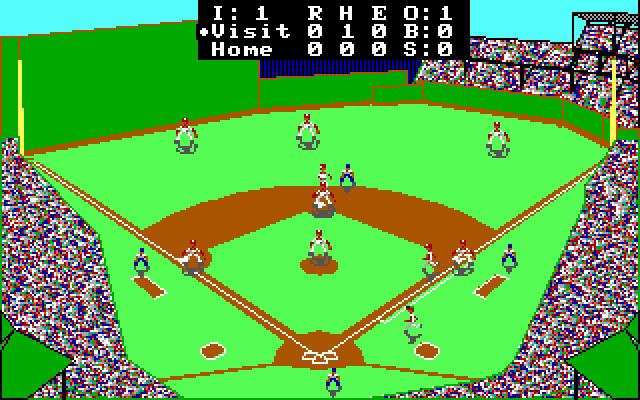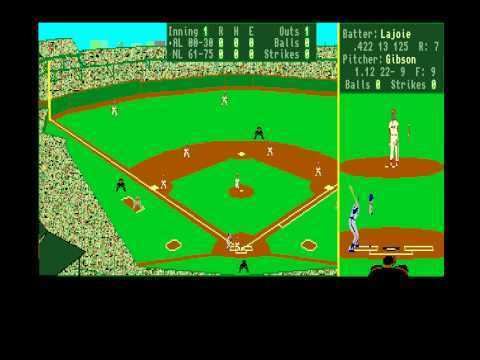8.6 /10 1 Votes
Release date(s) 1987 Initial release date 1987 | 4.3/5 My Abandonware Genre(s) Sports game | |||||||||||||||||||||||||||||||||
 | ||||||||||||||||||||||||||||||||||
Mode(s) Single player, Two Player, Computer vs. Computer Similar Don Daglow games, Sports games | ||||||||||||||||||||||||||||||||||
Earl weaver baseball gameplay pc game 1987
Earl Weaver Baseball is a baseball computer game (1987), designed by Don Daglow and Eddie Dombrower and published by Electronic Arts. The artificial intelligence for the computer manager was provided by Baseball Hall of Fame member Earl Weaver, then manager of the Baltimore Orioles. EWB was a major hit, and along with John Madden Football helped pave the way for the EA Sports brand, which launched in 1992.
Contents
- Earl weaver baseball gameplay pc game 1987
- Earl weaver baseball pc 1987 video game years history
- Innovations
- Gameplay
- Minor glitches
- Technical info
- Commissioners Disk
- Earl Weaver Baseball II
- I Got It Baseball
- Reception
- Awards
- References

Daglow and Dombrower had previously teamed together to create Intellivision World Series Baseball at Mattel in 1983, the first video game to use multiple camera angles and the first console sports sim.

Daglow and Dombrower interviewed Weaver in his hotel room in a series of meetings over a period of months during the 1985 season for managerial AI. Dombrower actually apologized to Weaver at one point for taking up so much of his free time, but Weaver told him that he never had anything to do during road trips and never left his hotel room, anyway. In addition, he loved talking baseball strategy, and he was having a great time.

Earl weaver baseball pc 1987 video game years history
Innovations
EWB included many features that subsequently became part of most or all computer baseball sims through the present day:
Gameplay
The gameplay was unusual in certain respects. The gamer had no control over the fielders, except where to throw the ball. The pitcher/batter interface was top-down in the Amiga version, and foreshortened in the DOS version.
Players were rated from 1 to 10, but the editor allowed players to effectively go up to 15 (after which it reset.) Players with 15 pitching speed, for example, could reach 100+ mph on their fastballs. Players with 15 running speed were already on second on a stolen base when the catcher's throw was 2/3 of the way to second. Also, any player with a runner rating higher than 10 could never be thrown nor tagged out. This meant that every such player would automatically get an inside-the-park home run on any ground bunted ball.
There was no trade AI, so all trades were made manually.
The game featured a "practice" mode, in which the gamer could practice batting, pitching and fielding. The fielding practice was involving in that the computer would put the gamer through an authentic fielding practice (throw to first, turn a double play, etc.)
The player could go through an entire 162-game season if he wished, although there were no playoffs.
Minor glitches
The game was not without a few minor problems:
Technical info
The DOS version required 384k of RAM and supported CGA, EGA, or Tandy graphics. CGA was recommended for PCs under 12Mhz. The game offered the option of direct-register writes in EGA mode for better performance or using the BIOS instead, which was slow, but guaranteed compatibility with all hardware setups. VGA was not supported per-se, but when run in CGA mode, the game could use the VGA palette registers to select different colors aside from the default CGA ones (if a real CGA or EGA card was used, it would display in the standard red/green/yellow palette).
Commissioner's Disk
The Commissioner's Disk was released in 1988. It was an advanced player, stadium and team editor, able to make deeper changes, such as skin tone (in the original version, one had to clone a black player in order to create a new black player). It also featured a schedule generator, as well as advanced stat analysis, and so forth.
Earl Weaver Baseball II
Earl Weaver Baseball II (EWB2) was the sequel to the classic game, and featured many advances, including the first full 3D camera that would render a television-style viewing experience. This was made possible by a design decision Dombrower made at Mattel to use a 3D model of the game from the get-go in anticipation of this eventuality. However, the game was released prematurely by Electronic Arts, and Version 1.1, which fixed many of the small bugs that ruined some of its reputation, was never released. Notably, despite the 1991 release date, VGA graphics were still not supported by EWB2, only EGA and Tandy (CGA support was dropped). In 1992, a version of EWB2 was developed in conjunction with STATS, Inc., that would play back real baseball games using the EWB II display engine and live scoring information from each ballpark, but it was never finished or released. It was only released for DOS.
I Got It Baseball
In 2002, Dombrower released a version of EWB2 called I Got It Baseball as shareware, though in this version, the gamer can only manage, not participate. However, the managerial AI still remains, though now called "The Skipper". Also intact are the physics engine, the player AI, the fully developed team, player, and ballpark editors; stat accumulation, and a now-commonplace "QuickPlay" option. It can be downloaded at his website.
Reception
Computer Gaming World in 1987 called Earl Weaver Baseball "undoubtedly the most exciting sports simulations to be released in years". It praised the game's graphics and audio, and noted its extensive offensive and defensive options. The magazine named Earl Weaver Baseball its game of year for 1987, and in 1989 it named Earl Weaver Baseball to its Hall of Fame for games readers rated highly over time, with a score of 8.82 out of 12. Game reviewers Hartley and Patricia Lesser complimented the game in their "The Role of Computers" column in Dragon #126 (1987), calling it "the finest computer simulation for baseball we’ve ever seen" and "impressive beyond belief". The Lessers reviewed the IBM version of the game in the following issue (#127), and gave the game 4½ stars. They later reviewed the Commodore Amiga version in 1988 in Dragon #132, giving it 5 out of 5 stars. Compute! also praised Earl Weaver Baseball, stating "it is, without question, the closest we have to the ideal computer baseball game ... If you are a baseball fan, you will want this game. Period".
By contrast, Computer Gaming World in 1991 denounced Earl Weaver Baseball II as "herky-jerky, funhouse-mirror baseball ... a field-of-nightmares experience". The magazine stated that the sequel had ruined the original's attractive ballparks with "cancerous growths of looming grandstands", less information was available when planning strategy, the automated camera director was poorly implemented, and many features in the original game were now on the optional Commissioner's Disk. Bugs included assigning Connie Mack and John McGraw to the wrong leagues and a conversion utility for player disks that failed on an Electronic Arts-produced disk from 1990.
The game was a big hit for EA.
Awards
In 1996, Computer Gaming World named Earl Weaver Baseball one of the 25 Best Games of All Time on the PC.
Earl Weaver Baseball was named to the Computer Game Hall of Fame by Computer Gaming World and by GameSpy.
